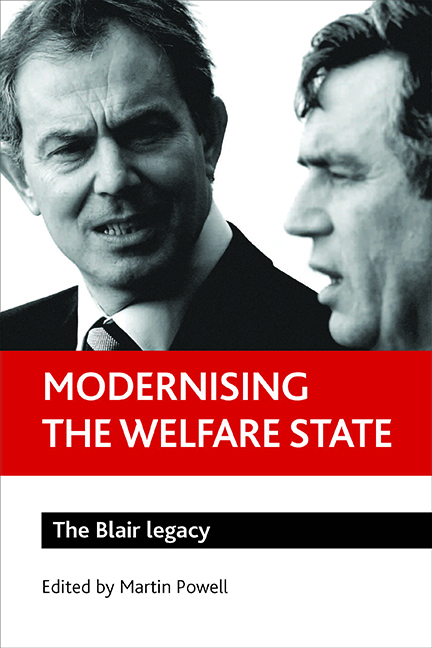Book contents
- Frontmatter
- Contents
- List of tables and figures
- Acknowledgements
- Notes on contributors
- one Introduction: modernising the welfare state
- two The NHS after 10 years of New Labour
- three Housing policy: coming in out of the cold?
- four Social security and welfare reform
- five Social care under Blair: are social care services more modern?
- six Education: from the comprehensive to the individual
- seven Controlling crime and disorder: the Labour legacy
- eight Social investment: the discourse and the dimensions of change
- nine Risk and the Blair legacy
- ten Going private?
- eleven Choice in public services: ‘no choice but to choose!’
- twelve The conditional welfare state
- thirteen The stages of New Labour
- fourteen Social Democratic reforms of the welfare state: Germany and the UK compared
- fifteen Conclusion: the Blair legacy
- Index
- Also available from The Policy Press
eleven - Choice in public services: ‘no choice but to choose!’
Published online by Cambridge University Press: 21 January 2022
- Frontmatter
- Contents
- List of tables and figures
- Acknowledgements
- Notes on contributors
- one Introduction: modernising the welfare state
- two The NHS after 10 years of New Labour
- three Housing policy: coming in out of the cold?
- four Social security and welfare reform
- five Social care under Blair: are social care services more modern?
- six Education: from the comprehensive to the individual
- seven Controlling crime and disorder: the Labour legacy
- eight Social investment: the discourse and the dimensions of change
- nine Risk and the Blair legacy
- ten Going private?
- eleven Choice in public services: ‘no choice but to choose!’
- twelve The conditional welfare state
- thirteen The stages of New Labour
- fourteen Social Democratic reforms of the welfare state: Germany and the UK compared
- fifteen Conclusion: the Blair legacy
- Index
- Also available from The Policy Press
Summary
Introduction
During the second half of Tony Blair's premiership, the concept of choice came to symbolise the tensions within the Labour Party over the direction of welfare reform. Although those who were resistant to Blair's reforms were keen to stress that they were not anti-choice, it was clear that the word had become a rallying cry for the vanguard of Blairites such as Cabinet Ministers Alan Milburn (2001), Stephen Byers (2004) and John Reid (2005). A succession of reports published during Labour's second and third terms by think-tanks, parliamentary bodies and academics framed choice as the symbolic core of the Blairite welfare state (Greener, 2003; Lent and Arend, 2004; Clarke, 2005; Farrington- Douglas and Allen, 2005; PASC, 2005; Clarke et al, 2006). Choice was seen by some as the central strand of a broader commercial agenda in public services, in which the service user was being remade as a citizen-consumer (Hall, 2003; Needham, 2003, 2007; Marquand, 2004; Clarke et al, 2007). Part of Gordon Brown's positioning to become party leader involved endorsing the pro-choice thrust of specific Blairite policies (Tempest, 2004) while signalling his wariness about certain forms of choice and consumerism (Brown, 2003).
Like modernisation, choice is characterised by ‘indeterminacy’, laden with political significance but essentially vague in policy terms (Clarke et al, 2006). The same social, political and economic shifts that shaped the reinvention of the Labour Party as New Labour put choice centre stage: neoliberal political movements across English-speaking countries championed the moral primacy of choice in political life (Thatcher, 1987); sociologists pointed to the centrality of choice to a new reflexive individualism (Giddens, 1994); and economic observers identified post-Fordist modes of regulation which responded to consumer choices rather than production cycles (Murray, 1989; Warde, 1994). Thus, like modernisation, choice came to be presented as part of New Labour's progressive logic, an inevitable response to a new political terrain.
However, also like modernisation, choice under New Labour has taken many forms, about which it is difficult to generalise. Drawing on Hall's (1993) orders of change, it is possible to see choice expressed in the overarching goals of public policy, in the policy instruments used to attain those goals and in the precise settings of those instruments.
- Type
- Chapter
- Information
- Modernising the Welfare StateThe Blair Legacy, pp. 179 - 198Publisher: Bristol University PressPrint publication year: 2008



